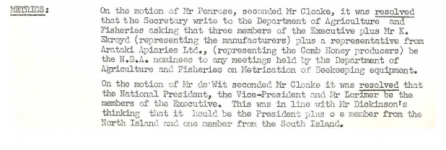Sorry. What I was meaning was those dimensions were arrived at over a several year period in the middle 1970s, and yes, they were adopted by the industry. As near as I can tell, these sizes (as based on 20mm dressed timber) have always been considered a 'standard' - even if, as you say, you are not cutting to them now.
In 1974, the NBA put forward 3 exec members and 2 others - see the article attached - Kevin Ecroyd to represent the manufacturers, and someone from Arataki to represent comb honey producers - to come up with figures and 'adopt' them - the figures from Graeme Walton's article is what they arrived at.
I think where the issue arose was that the timber industry did not ever, ultimately fully adopt the measures that the beekeeping industry had been told to work with, and beekeepers ended up with a small range of timber thickness to work with, and *could* get thicker than 20mm.
I do remember beekeepers being upset when told the only dressed timber they would be able to work with was 20mm - it wasn't a choice. I do kind of remember some issues, but according to Graeme Walton "The timber industry intends milling timber exclusively in metric dimensions in 1975. New Zealand's major manufacturer of equipment has indicated that, as from April 1975, all hive equipment will be cut to the metric hive specifications adopted in this report."
I remember going to Sawyer's Rd in late 1975 and buying a heap (for me) of boxes and frames - but I certainly couldn't tell you the thickness of the timber! So as you tell me they are not being used as that by the manufacturers, I can only say I'm not surprised people may have troubles.
It may not be so critical now. What those 'standards' were trying to sort out was when someone had both old and metric equipment. It simply wouldn't have done to, say, not be able to fit an old lid on top of a new metric box! But now, nearly 50 years later, there may not be much of that old equipment still on hives!
PS - Damn nice to hear from you, Stuart!



